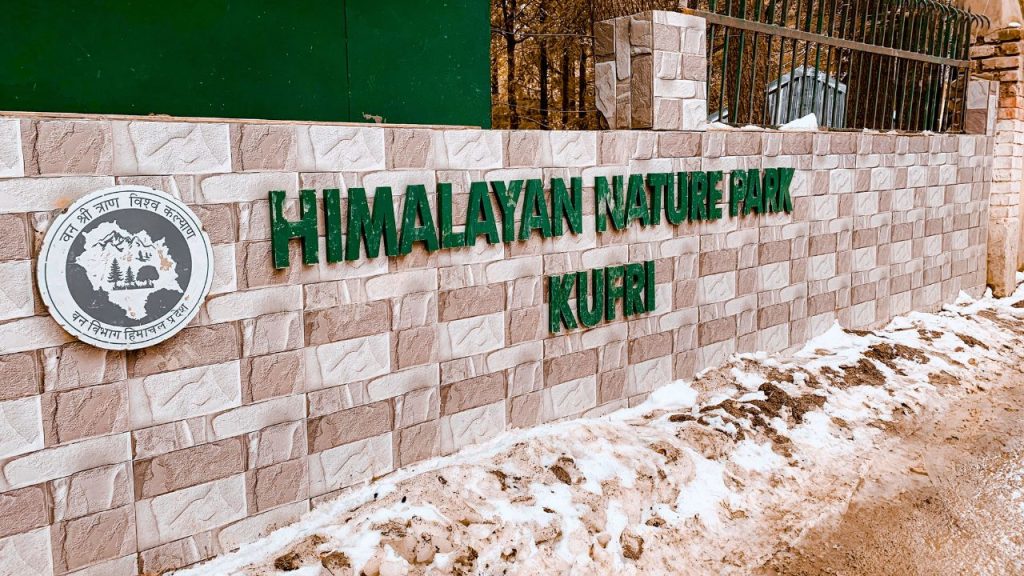The Himalayan Nature Park Kufri is on the snow-fall hills 8000 ft above sea level. The park stretches to 90 hectares. Some animals with rare numbers live in the nature park and its alpine meadows have different types of flora. Forest Department of Himachal Pradesh arranges special programs related to Himalayas flora and fauna for which-majority is not aware.
Few of the carnivorous animals that a visitor can spot here at Kufri Nature Park include snow leopard, Tibetan wolf, Common Leopard, Brown Bear and Asiatic black bear. Mammals, like Musk Deer, Hangal, Bharal, Goral ,Sambhar and Barking Deer are present in abundance. Among the avifauna Crested Kalij, Cheer and Monal Pheasants are some birds who have made National Park as their home. Also a perfect spot for watching the Himalayan range and snow peaks.
Most likely, the best way to discover herbaceous plants and trees of any nature park is a trekking – it will be led by park rangers at Sai Ropa Tourist Center. Camping can also be done here, but a prior permission is first required from the division officer. It has some of the common shrubs and bushes such as Blue Pine, Deodar, Holly Oak and Spruce. Moreoverthe tourists will observe a variety of flowers that bloom on the greenery of Kufri Nature Park. This destination is full of flowers like the Germanium, Orchids, Balsams and Primula.
On a sunny day Kufri Nature Park looks resplendent, waving at the breeze and surrounded by prominent 2600 m mountains that sport glistening glaciers with snow clad peaks all around.#
- Geography
- Overview
- Things to Do in Himalayan Nature Park Kufri
- Timing and Entry Fee of Himalayan Nature Park Kufri
- Best Time to Visit Himalayan Nature Park Kufri
- How To Reach Himalayan Nature Park Kufri
- Travel Tips
- Distances
- Where to Stay near Himalayan Nature Park Kufri
- Conclusion
- FAQ’s Himalayan Nature Park Kufri
Geography

The Himalayan Nature Park (Kufari), Himachal Pradesh is an important wildlife park and is rich in flora & fauna. The park possesses a few unique geographical characteristics:
1. Location: The Himalayan Nature Park is at a distance of 16 km from Shimla, the state capital and near Kufri. It is 2,700 meters above sea level.
2. Topography: It is in the picturesque Himalayan mountain ranges. The place has Pine and Deodar Trees, which covers the hill.
3. Flora: The region supports a diverse variety of Himalayan flora; such as oak, cedar and rhododendron trees which we find only in this part of the world. These forests are characteristic of the Western Himalayan broadleaf forests ecoregion.
4. Fauna: It is known for being a staple of the famous Himalayan Nature Park. Several endangered species such as the Himalayan Monal (the state bird of Himachal Pradesh), musk deer, barking deer and also rare snow leopard are found here.
5.Climate: The climate here is of temperate type. Mild summers with temperatures of 12°C to 19 °C (54°F-66°F), are contrasted by cold winters where the temperature can frequently drop below freezing.
6. Tourism: Owing to the rich biodiversity and picturesque settings, Himalayan Nature Park is flocked by tourists as well as nature lovers round the year. It also provides for trail hiking, birding and wildlife photography.
7. Conservation: The natural treasure trove of Himalayan flora and fauna is conserved in the park. It has been subject of conservation initiatives aimed at maintaining its original habitat so that the species living in it have an appropriate open space to raise their young.
Overview
- Location and Access: Located near Kufri, about 16 kms from Shimla (capital of Himachal Pradesh) the park is well connected by road. Surrounded by beautiful mountain and valley landscapes, thanks to its Himalayan foothills location.
- Vegetation: The park accommodates an extensive number of himalayan vegetation like oak, cedar-pine fir and rhododendron plant. The forests are part of the Western Himalayan broadleaf forests ecoregion, and a key representation of Central Asian mid-mountain wet temperate trans palearctic vegetation.
- Flora: The Himalayan Nature Park is famous for its rich vegetation and all kinds of animals. It has a large number of species that live in their natural habitat. A few of the indigenous species that visitors may spot here are – The Himalayan Monal (the state bird of Himachal Pradesh), musk deer, barking deer and leopard cat. The park also hosts a Zoo section which has animals like the Sambar deer, Tibetan Wolf and Black bear.
Things to Do in Himalayan Nature Park Kufri

- Wildlife: Guided entry tours and specific watchful watching sites located at the park.
- Hasty Trails: well signed hiking and nature trails with birding opportunities, quiet settings.
- Interpretation Centers: Educational shows and exhibits featuring the biodiversity of the park, its conservation program, and local ecosystems.
- Spot for picnics: Where the park you let yourself from nature and relax picnic areas
- Preservation Himalayan Aspect Park: The active participation of wildlife and supporting the Jungle is very important. It aims to conserve the biodiversity of the Himalayas, focusing on preserving those relatively fragile few sacred landscapes which are yet unperturbed by man and where over 60 critically endangered plant species survive today.
- Visitor Services: The park has parking, restrooms and an information center. This guarantees a comfortable and reassuring experience for people visiting the park.
Timing and Entry Fee of Himalayan Nature Park Kufri
Entry Charges
- ₹60/- for adults
- ₹20/- for children
Zoo Timings
- Winter – 09:30 Hrs. to 17:30 Hrs.
- Summer – 09:00 Hrs. to 18:30 Hrs.
Best Time to Visit Himalayan Nature Park Kufri
- March to June and mid-September to November are the best months to visit.
- Summer (April to June): The weather is pleasant and ideal for outdoor activities such as hiking and wildlife viewing.
- Winter (December to February): If you enjoy snow and winter sports, this is the perfect time to visit Kufri and the surrounding areas.
- Monsoon (July to September) : In the Himalayas, typically brings heavy rainfall. Expect cloudy and misty weather with occasional showers. Rain gear such as umbrellas and waterproof jackets are essential.
How To Reach Himalayan Nature Park Kufri

By Air:
Chandigarh Airport is the nearest airport (approx 132 km) or you can also land at Shimla Airport which rests between an approx of 32km. In all cases you would have to take a taxi or book another car depending on the airport.
Via Train:
The nearest large railway station is Shimla(19 km). Once you are here, hire a taxi or take the local bus to Kufri.
By Road:
Kufri is located 16 kms away from Shimla. From Shimla bus stand to Kufri you can either book a taxi or take a local bus. Also, the road is well-preserved and you have beautiful landscapes along your way.
Chandigarh/Delhi: If you reach Shimla from Chandigarh or Delhi, hop into a bus/ hire taxi to Shimla and head towards Kufri.
By Local Transport: When you arrive at Kufri, from there hitch a local taxi or walk till the Himalayan Nature Park. Fagu is situated near the famous mountain terrain of Kufri, right on the main road and that makes it an easily accessible destination.
Travel Tips
- Abide by park rules and keep a safe distance from animals
- Carry Wildlife viewing and wildlife photography equipment such as binoculars and cameras.
- Interact with the local guides or park staff to understand more about wildlife and habitats
- Be sure to wear good walking shoes or hiking boots for exploring the nature trails.
- Bring snacks and water you will definitely want them on longer hikes.
Distances
- Delhi to Himalayan nature park : 371 Kms
- Chandigarh to Himalayan nature park : 128 Kms
- Manali to Himalayan nature park : 250 Kms
- Shimla to Himalayan nature park : 18 km
- Dharamshala to Himalayan nature park : 190 km
- Rohru to Himalayan nature park : 96 Kms
- Rampur to Himalayan nature park : 114 Kms
8. Kangra to Himalayan nature park : 230.1 km
Where to Stay near Himalayan Nature Park Kufri

- The Ananda Kufri :
Address : National Highway 22, Kufri, Himachal Pradesh 171012
P.no : 01772648888
- Hotel Kufri Holiday Inn
Address : Holiday Inn, Hotel, Main Bazaar, Kufri, Himachal Pradesh 171012
P.no : 09218301111
- Kufri Star Inn (A Unit of Trip Platter)
Address : Kufri Bypass Rd, Kufri, Himachal Pradesh 171012
P.no : 07018630158
Conclusion
Kufri Himalayan Nature Park, is an attractive ravine-like region near the hill station of Kufri at Himachal Pradesh in India for nature lovers. A crucible of indigenous flora and fauna. Its dense forests provide a natural habitat for many species of mammals and numerous bird species including the musk deer (mainly found on higher elevation), Himalayan Monal.
The surrounding mountains provide picturesque scenery to the park, which is part of what attracts tourists looking for both natural beauty and wildlife encounters. With the cool atmosphere and well-kept trails, this place is perfect for hiking as well as a bird-watcher’s paradise bringing scores of nature lovers from all over.
Lastly, the Kufri Himalayan Nature Park is a perfect reminder of how diverse the plants and animals are in this part of your world and it will offer much calm to you as an individual especially if peace surrounds fine looking natural landscapes. In addition, it provides a habitat conservation of the unique flora and fauna in Himalaya not only for tourists but also bequeath to their next generation.
FAQ’s Himalayan Nature Park Kufri
Q.1. What are the entry fees of Himalayan nature park ?
Ans. The entry fees of Himalayan nature park is as follow :
- ₹50/- for adults
- ₹25/- for children
Q.2. Is Kufri famous for its Himalayan national park?
Ans. One of the most famous tourist attractions in Kufri, the Himalayan National Park boasts of 180 species of birds and rare mammals. It was established in 1984 and formally declared as a National Park in the year 1999.
Q.3. What animals are in the Himalaya National Park?
Ans. Most Himalayan fauna are protected under the Indian Wildlife Act, including the bharal (blue sheep), common leopard, snow leopard, Himalayan brown bear, Himalayan tahr (wild goat), musk deer and serow (goat-like antelope).
Q.4. Is Kufri National park closed on Monday?
Ans. Kufri National Park is closed on Tuesday, not on Monday.








